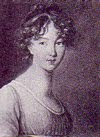The pattern is from A Winter Gift for Ladies Being
Instructions in Knitting, Netting and Crotchet (sic) Work. Containing the
Newest and Most Fashionable Patterns. From the Latest London Edition Revised
and Enlarged by An American Lady. Philadelphia: G.B. Zieber & Co. 1848.This
book is available from http://www.antiquepatternlibrary.org
This purse has been pictured twice*, that I know of, with
the striped bag I am making that is also from the V&A’s collection.** The
entry on the museum’s page does not give any measurements but, from the
photographs in the two publications in which it appears, the Porcupine purse is
shorter than the striped bag and considerably narrower.
The American Lady states that “Four fine needles” are needed
but no specific size is stated. She also suggests “netting silk” and “one
string of gold beads.” I am using 1.25mm/US 0000 needles and they are fine.
The purse in the V&A was knit, according to its
description, “in silk threads” and “lined with green silk.” I am knitting the
purse with three strands of DMC 25 Mouliné Spécial
embroidery floss (934, 937, 754, 725, 3712 and Ecru) and am not putting beads
on the purse.
I am making a larger version in tandem, using Sally
Pointer’s Wicked Woollens’s pattern*** which is a fairly faithful adaptation of
the original pattern, and calls for 2.00mm/US 0 needles and fingering weight
yarn. I chose Knit Picks’s Palette in Ivy, Currant, Blush, Mustard, Peony and
Blue Note Heather, luckily all in my stash. Some of the colours are faithful to
the purse in the V&A but I changed a green to currant and the white accent
colour to a blue. As with the
smaller purse, I will not be putting beads on this one.

There is a considerable difference in the sizes. The little
bag is coming out at 4 ¼” around or almost 2” flat. The length, so far, at just
over halfway knit, is just about 3 ½” from the needles to one of the pointed
tips. The larger bag is 9” around, 4” flat and 5 ¾” long so far. I still have seven more sections to
knit on each purse. When finished, they will be is turned inside out and the honeycomb sections will then be
pointed. Linings, drawstring handles and some finishing touches on the bottom
of the purses will make them ready for use.
*Knit One, Purl One –
Historic and Contemporary Knitting from the V&A’s Collection by Frances
Hinchcliffe, Department of Textiles and Dress, London: Precision Press, 1985 and Miller’s Collecting Textiles by Patricia Frost,
London: Octopus Publishing Group, Ltd., 2000

















